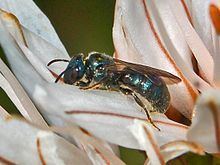Rank Species | ||
 | ||
Similar Ceratina, Ceratina cucurbitina, Epeolus variegatus, Anthophora quadrimaculata, Anthophora furcata | ||
Ceratina cyanea, common name blue carpenter bee, is a species of bee belonging to the family Apidae.
Contents
Description
Ceratina cyanea can reach a length of 5–9 millimetres (0.20–0.35 in) (females) and 5–7 millimetres (0.20–0.28 in) (males). Head, chest and abdomen show a metallic blue colour. These bees have three submarginal cells in forewings, club-shaped antennae and a long thin tongue. The scutellum is densely punctured. The seventh tergite has a deep saddle and ends in two points.
The blue carpenter bees fly from mid-March to mid-October, collecting pollen at various families of plants, especially knapweed (Centaurea), yellow composites (Asteraceae) and Lotus (Fabaceae).
Females nest in the vertical or slanted dead plant stems, such as thistles, blackberries (Rubus species), elderberries (Sambucus species) and roses. Then they provide the cells with a mixture of regurgitated nectar and pollen to feed the larvae. Adult males and females overwinter inside their cells into the stems. Often several insects spend the winter together.
Habitat
This undemanding species colonize both dry habitats and wetlands. It inhabits forest edges, thickets and gardens.
Distribution
This species is present in most of Western Europe, in North West Africa and in the East Palaearctic ecozone (excluding China).
